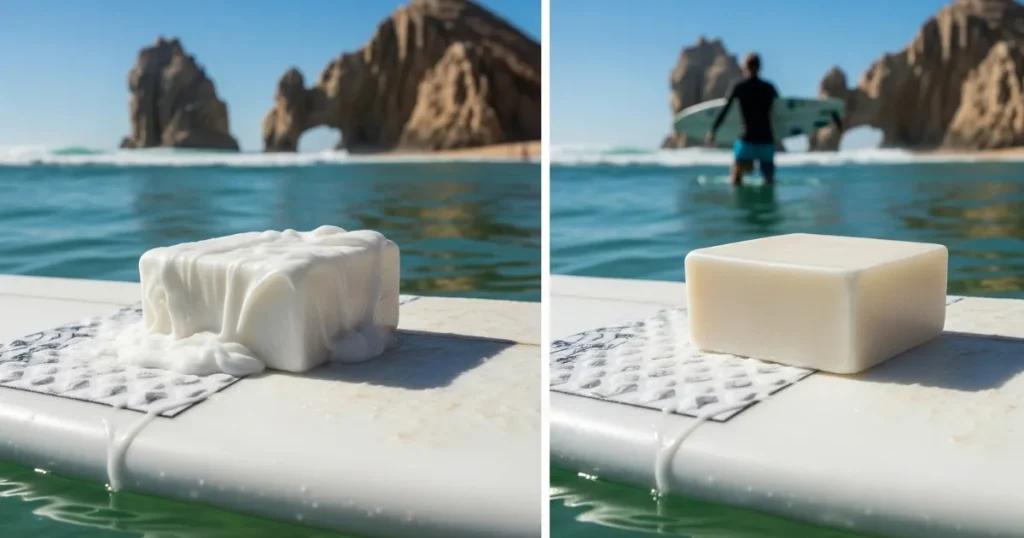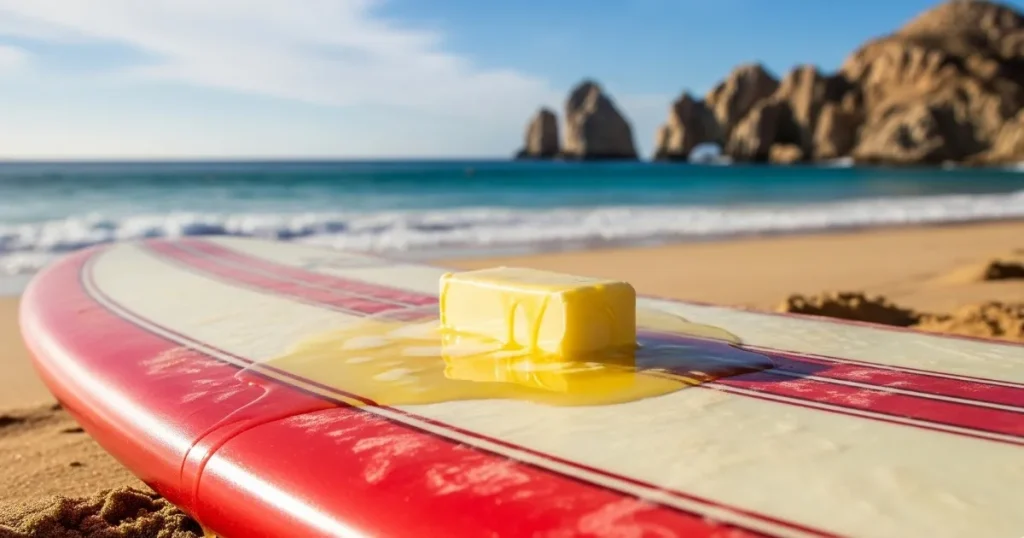Are you stoked to shred some waves in the beautiful waters of Cabo San Lucas? This Baja paradise offers incredible surf, but before you paddle out, there’s a crucial piece of gear you need to consider: your surf wax for Cabo’s warm water. Using the wrong type of wax can be the difference between an epic session and a frustrating series of wipeouts.
Many surfers, especially those traveling from cooler climates, make the mistake of using the same surf wax they use back home. However, the tropical water temperatures of Cabo demand a specific type of wax. Understanding the science behind surf wax and choosing the right formulation for the local conditions is key to maximizing your grip and performance on the waves.
At Surf Shop Cabo, we see countless surfers struggle with the wrong wax. They end up slipping and losing control, hindering their ability to enjoy the amazing waves Cabo has to offer. That’s why we’ve created this guide to help you understand the importance of using the correct surf wax for Cabo’s warm water.
In this article, we’ll dive into the different types of surf wax, explain why water temperature matters, and guide you in choosing the perfect surf wax for Cabo’s warm water. We’ll also cover application tips and the importance of removing old wax to ensure optimal traction. Get ready to unlock the secret to catching more waves in Cabo!
Why Water Temperature Matters for Surf Wax

Surf wax isn’t just a sticky substance; it’s a carefully formulated blend of waxes and other ingredients designed to provide optimal grip based on water temperature. The key factor is the wax’s melting point. Colder water requires a softer wax that remains tacky even in low temperatures.
Conversely, warm water necessitates a harder wax with a higher melting point. If you were to use a soft, cold-water wax in the balmy waters of Cabo, the heat would quickly cause it to melt and become slick. This would leave you with little to no traction, making it incredibly difficult to stay on your board, let alone perform any maneuvers.
Think of it like this: butter softens in warm temperatures, making it slippery. The same principle applies to surf wax. A wax designed for colder climates will become too soft in Cabo’s heat, losing its grip. Therefore, selecting the right surf wax for Cabo’s warm water is not just a suggestion, it’s a necessity for a safe and enjoyable surf session.
Using the incorrect wax can not only ruin your session but can also be dangerous. Slipping frequently can lead to falls, potential collisions, and overall frustration. Investing in the appropriate surf wax for Cabo’s warm water is a small price to pay for enhanced safety and significantly improved performance on the waves.
Understanding Different Types of Surf Wax
Surf wax is typically categorized based on water temperature: cold, cool, warm, and tropical. Each type has a different level of hardness and stickiness to perform optimally within its intended temperature range. Trying to use a “one-size-fits-all” wax will inevitably lead to subpar performance in varying water conditions.
Cold-water wax is the softest and stickiest, designed for water temperatures below 60°F (15°C). Cool-water wax is slightly harder and suitable for temperatures between 60°F and 70°F (15°C and 21°C). Warm-water wax is firmer still and ideal for water temperatures ranging from 70°F to 80°F (21°C to 27°C).
Tropical wax is the hardest formulation, specifically designed to withstand the high water temperatures found in regions like Cabo San Lucas, typically above 75°F (24°C). Using tropical surf wax for Cabo’s warm water ensures that the wax remains effective even under the intense Baja sun and in the consistently warm ocean.
At Surf Shop Cabo, we primarily stock warm and tropical waxes to cater to the local water conditions. Our experienced staff can help you determine the best surf wax for Cabo’s warm water based on the current temperature and your personal preferences for grip. Don’t hesitate to ask for recommendations!
Why Cold-Water Wax Fails in Cabo

Imagine taking a stick of butter straight from the fridge and leaving it in the Cabo sun. It would quickly melt into a greasy mess, losing its solid form and any semblance of its original texture. This is precisely what happens when you use cold-water surf wax in Cabo’s warm waters.
Cold-water wax is formulated with softer waxes and oils to maintain its tackiness in low temperatures. When exposed to the heat of Cabo’s ocean, this softer composition becomes overly pliable and melts easily. Instead of providing a grippy surface, it creates a slick, oily layer on your board, making it virtually impossible to maintain your footing.
The result is constant slipping, missed wave opportunities, and a thoroughly frustrating surfing experience. You’ll spend more time falling off your board than actually riding waves. To avoid this common pitfall, always choose surf wax for Cabo’s warm water that is specifically designed for higher temperatures.
Not only does cold-water wax become ineffective in warm water, but it can also be difficult to remove from your board afterwards. The melted wax can spread and create a sticky residue that requires extra effort to clean. Save yourself the hassle and ensure a better surf session by using the appropriate surf wax for Cabo’s warm water.
Choosing the Right Surf Wax for Cabo
When selecting surf wax for Cabo’s warm water, you’ll primarily want to focus on warm and tropical formulations. These waxes are engineered to maintain their hardness and grip even when the water temperature climbs. Checking the temperature rating on the wax packaging is the best way to ensure you’re making the right choice.
Consider the specific time of year you’ll be surfing in Cabo. While the water is generally warm year-round, there can be slight variations in temperature. During the summer months, a tropical wax will likely be your best bet, offering the highest melting point. In the cooler months (though still warm), a warm-water wax might suffice.
At Surf Shop Cabo, we carry a wide selection of high-quality warm and tropical surf waxes from reputable brands. We understand the specific needs of surfers in Cabo and only stock products that perform well in our local conditions. Our team can provide personalized recommendations based on your surfing style and the current water temperature.
Don’t underestimate the impact of using the correct surf wax for Cabo’s warm water. It’s a small investment that can make a huge difference in your surfing experience. Stop by Surf Shop Cabo before hitting the waves and ensure you’re properly equipped for an epic session.
Tips for Applying and Maintaining Surf Wax
Applying your surf wax for Cabo’s warm water correctly is just as important as choosing the right type. Start with a clean, dry surfboard deck. If there’s old wax, be sure to remove it completely using a wax comb or a dedicated wax remover. A clean surface allows the new wax to adhere properly and provide maximum grip.
Begin by creating a base coat with firm, even strokes, applying the wax in a crosshatch pattern. This creates a textured foundation for the top coat. Once you have a good base, apply a softer top coat with lighter, circular motions. This will create the bumpy, sticky surface that provides excellent traction for your feet.
Apply more wax in the areas where your feet will be positioned. Don’t over-wax, as too much wax can actually reduce grip. A thin, evenly distributed layer with plenty of bumps is ideal. Reapply wax before each surf session, especially if the existing wax feels slick or worn down.
Regularly inspect your wax and remove any sand or debris that may get stuck in it. Over time, old wax can become less effective and even attract dirt. Consider stripping and reapplying fresh surf wax for Cabo’s warm water every few surfs to maintain optimal grip and performance. Using a wax comb to create fresh bumps before each session can also help prolong the life of your wax job.

